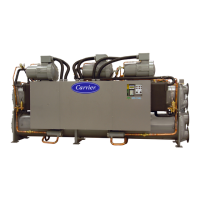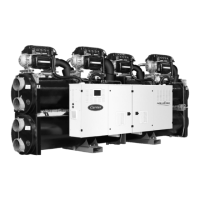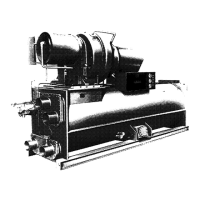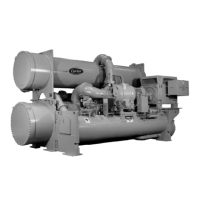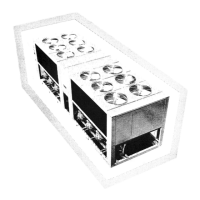12
GENERAL W7220 CONTROLLER AND SENSOR
INFORMATION
W7220 Economizer
The economizer controller used on electromechanical units is a
Honeywell W7220, which is located in the RTU base unit’s
Control Box. See the base unit’s Installation Instructions for the
location of the Control Box access panel.
The W7220 controller provides the following:
• 2-line LCD interface screen for setup, configuration, and
troubleshooting.
• On-board fault detection and diagnostics
• Sensor failure loss of communications identification
• Automatic sensor detection
• Capabilities for use with multiple-speed indoor fan systems
User Interface
The user interface consists of a LCD (liquid crystal display) dis-
play and a 4-button keypad on the front of the economizer con-
troller.
Keypad
The four navigation buttons (see Fig. 27) are used to scroll
through the menus and menu items, to select menu items, and to
change parameter and configuration settings.
Using the Keypad with Menus
To use the keypad when working with menus:
•Press the ▲ (Up arrow) button to move to the previous
menu.
•Press the ▼ (Down arrow) button to move to the next
menu.
• Press the (Enter) button to display the first item in the
currently displayed menu.
• Press the (Menu Up/Exit) button to exit a menu’s item
and return to the list of menus.
Fig. 27 — W7220 Controller
Using the Keypad with Settings and Parameters
To use the keypad when working with set points, system and ad-
vanced settings, checkout tests, and alarms:
1. Navigate to the desired menu.
2. Press the (Enter) button to display the first item in the
currently displayed menu.
3. Use the ▲ and ▼ buttons to scroll to the desired parameter.
4. Press the (Enter) button to display the value of the cur-
rently displayed item.
5. Press the ▲ button to increase the displayed parameter value.
6. Press the ▼ button to decrease the displayed parameter value.
NOTE: When values are displayed, pressing and holding the ▲or
▼ button causes the display to automatically increment.
7. Press the (Enter) button to accept the displayed value and
store it in nonvolatile RAM (random-access memory).
8. The message “CHANGE STORED” displays.
9. Press the (Enter) button to return to the current menu
parameter.
10. Press the (Menu Up/Exit) button to return to the previous
menu.
Programming the W7220 Controller
The next several pages detail the different status displays, set
points, setup, and alarms available on the controller. The list below
and Table
8 summarize the inputs required for a standard
application with a single outside air sensor.
NOTE: Instead of setting the SETPOINTS, you can use the
defaults already set in the controller. See default settings below.
See Table
8 for summarized standard settings or, for more detail,
see Table 9, Menu Structure.
SETPOINTS
• MAT SET: This sets the mixed air temperature (MAT)
setting. The controller has a default of 53°F, but the range
is anywhere from 38°F to 70°F.
• LOW T LOCK: This setting locks out the compressor (or
mechanical cooling) at a given temperature. The default is
32°F, but the controller’s range is from –45°F to 80°F.
• DRYBULB SET: If you have an economizer with a dry
bulb outside air sensor, you will see and set the
DRYBULB SET. The default setting is 63°F but the
controller’s range is 48°F to 80°F.
• ENTH CURVE: If you have a single enthalpy outside air
sensor instead of a dry bulb, you will see and set the ENTH
CURVE setting. There are 5 setting options: ES1 thru ES5.
Check Table 6 for the limits for each of these settings. ES3
is the default setting.
• MIN POS: The minimum position allows for ventilation even
when not in the free-cooling mode. If you have a single speed
unit there will be only one minimum position setting. The de-
fault is 4.4-v, but the range is 2 to 10 vdc.
• MIN POS H and MIN POS L: If your unit is 2 speed, there
will be 2 minimum position settings that show up on the
menu. The first is MIN POS H (for high speed), which has a
default of 4.4-v. The second is MIN POS L (for low speed),
which has a default of 6.0-v.
NOTE: MIN POS H and MIN POS L are only displayed if under
SYSTEM SETUP, AUX2 IN is set to “W1”, and FAN TYPE is
set to 2 speed.
SYSTEM SETUP
• INSTALL: Allows you to set the current date. Use the
keypad buttons to scroll to the correct date.
• EQUIPMENT: Always set to CONV even if the unit is a
heat pump.
• AUX2 IN: Always set to W.
• FAN TYPE: Set for either single speed or 2 speed. The
default setting is 2 speed.
• AUX OUT: If remote Fault Detection and Diagnostic
(FDD) monitoring is required, select SYS.
• OCC: occupancy, always set to INPUT

